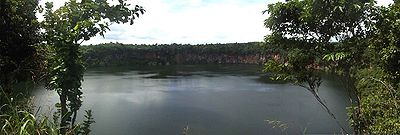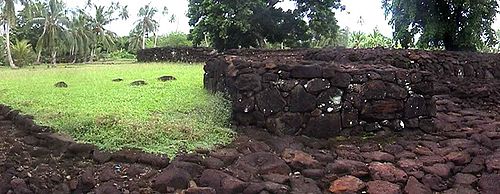- Wallis (island)
-
Kingdom of ʻUvea Puleʻaga Hau ʻo ʻUvea

Motto: Liberté Egalité Fraternité
French mottoCapital
(and largest city)Matāʻutu
13°16′S 176°12′W / 13.267°S 176.2°WOfficial language(s) Wallisian: ʻUvean, Français Demonym Wallisian Government French overseas collectivity - King "Lavelua" Kapeliele Faupala - Prime Minister "Kalae Kivalu" Setefano Hanisi - Bishop of Diocese Ghislain de Rasilly Traditional Customary Kingdom - France French overseas collectivity July 29, 1961 Area - Total 96 km2 (211th)
102 sq mi- Water (%) negligible Population - 2008 estimate 10,731 - Density 111,36/km2
149.9/sq miCurrency CFP franc Time zone (UTC+12) Drives on the right Internet TLD .wf Calling code 681
Wallis (Wallisian:ʻUvea) is an island in the Pacific Ocean belonging to the French overseas collectivity (collectivité d'outre-mer, or COM) of Wallis and Futuna. The island is a little Polynesian Kingdom, it is an aristocratic monarchy ruled by the noble families called the "ʻAliki" through the Customary system, the "Puleʻaga Hau o Lavelua". ("Lavelua and his Kingdom"). The power are shared between French Administration, Roman Catholic Church and Traditionnal System "Pule'aga Hau". The limits of each one are defined by the Territorial Statute of July 29th, 1961, traditionally called "Statut 61" ( Wallisian:Tohi Lao).Contents
Geography
The island has an area of 77,5 km² and a circumference of c. 50 km. Its highest point is Mount Lulu Fakahega (131 m). There are also a handful of large lakes, a sign of the island's volcanic origin, some of them almost perfect circles and with straight vertical walls, like Lalolalo, Lanu'tavake.
Uvea is located 240 km northeast of Futuna and Alofi islands. Together with some 15 smaller islands surrounding it, on its huge barrier reef, it forms the Wallis archipelago. Wallis has a fertile volcanic soil and sufficient rainfall to allow subsistence farming.
Uvea sub-divides into 3 district (from north to south):
- Hihifo : 5 Villages : Vailala, Tufuone, Vaitupu, Malae, and Alele.
- Hahake : 6 Villages : Liku, Aka'aka, Mata-Utu, Ahoa, Falaleu, and Ha'afuasia.
- Mu'a : 10 Villages : Lavegahau, Tepa, Gahi, Ha’atofo, Mala’efo’ou, Kolopo, Halalo, Utufua, Vaimalau, and Teesi.
District (meaning) Capital Area
(km²)Population
Census 2003Villages Hihifo (west) Vaitupu 23.4 2422 5 Hahake (east) Matāʻutu 27.8 3950 6 Mu'a (first) Mala'efo'ou (1) 26.3 3699 10 'Uvea (Wallis) chiefdom Matāʻutu 77.5 10071 21 (1) formerly called Mua
History
Archaeological excavations have identified sites on Wallis dating from circa 1400 AD. It was part of the Tongan maritime empire from around the 13th to 16th century. By that time the influence of the Tuʻi Tonga had declined so much that ʻUvea became important in itself. Several current, high ranking Tongan titles, like Halaevalu, trace their descent from ʻUvea. A legendary large canoe, the Lomipeau was built on the island as a donation to the Tuʻi Tonga. The big fortress of Talietumu close to Lotoalahi in Mua was the last holdout of the Tongans until they were defeated. The ruins of the place are still a tourist attraction:
The island was renamed Wallis after a Cornish navigator, Captain Samuel Wallis, who discovered it while sailing the HMS Dolphin on August 16, 1767, following his discovery of Tahiti.
On 5 April 1842 the authorities of Wallis Island requested protection by France with a protectorate treaty signed in April 1887.[1] After a referendum in 1959, Wallis became a French Overseas Territory in 1961.
Administration and Institutions
ʻUvea (Wallis) is one of the three traditional kingdoms of Wallis and Futuna, the other two being Alo and Sigave in the Hoorn Islands (Futuna Islands). Its capital, Matāʻutu, located on the east coast, is also the capital of the whole territory, Wallis and Futuna. The kingdom is divided into three districts, which are listed from north to south:
The King of Uvea is called the "Lavelua". As Lavelua, he lives in the royal palace called "SagatoSoane". (Official Residence of the King of ʻUvea). In front of the Palace is the SagatoSoane's Square. (Mala'e SagatoSoane)
The King appoints the ministers, who are among 6. Each Ministers hold a noble title (established under the reign of the Queen Amelia) who correspond to ancient great reigning lineage families. The King has to choose in one of each families and this choice is often contested by other family members. But they are obliged to respect. By odre of precedence :
- Kalae Kivalu (District of Hahake)
- Mahe Fotu'aika (District of Mua)
- Ulu'imonua (District of Hihifo)
- Kulitea (District of Hihifo)
- Muko'ifenua (District of Mua)
- Fotu'atamai (District of Hahake)
The Kalae Kivalu is the Chief of the Customary Council of Ministers and Prime Minister.
The King also appoints, on proposition of the populations three chief for each district. They are called Faipule, and are responsible of Chief of villages (Pule Kolo or Aliki Kaifenua or Matapule "Tongan style"). They can raise the duties of general interest, and are established or discharged during general assemblies of village (Fono Fakakolo) with usually take place on sunday after the morning mass in the "Falefono".
Demographics
The population of the island was 10,071 in 2003 (67% of the territory's population). Most of the inhabitants speak ʻUvean (or Wallisian) as their mother tongue.
Culture and Religion
Religion ("Lotu") and Culture ("Aga'ifenua") are very close in Wallis. Everyday life is heavily influenced by Polynesian traditions and especially by the Roman Catholic Feasts. Each Village has its own Patron Saint. Each District has its Great Church. (the Chief Cathedral is Cathedral of Mata-Utu). Almost all the people are Roman Catholic ("Lotu Katolika"), and there are numerous religious buildings on the island.
At their arrival, Catholic Missionnaries were welcomed by the King Vaimua Lavelua then baptized "Soane-Patita Vaimua". Bishop Bataillon, become a very close relative of the Royal Families, as Private Councellar of the Queen Amelia, he established in 1847, the "Lano Seminary". (First Catholic Seminary of Oceania). Lano celebrated 150 years in 1997, the Anniversary was also attended by the Samoan, His Eminence Cardinal Pio Taofinu'u, who studied there in the 40's, and big delegation from Tonga, Samoa, Fiji and New-Caledonia.
Wallis and Futuna was Established as Apostolic Vicariate in November 11th 1935 and promoted as Diocese June 21st 1966.
In Wallis, Culture is very important and is treasured by the inhabitants. Simple things such as traditional events like the kava ceremony, going to church, doing the plantation, knowing how to fish and other stuff are just important to the Wallisians. Even though western culture has spread around most of the world we live in today, tradition and culture are still strong as ever.
Transportation
The only commercial flights that go to Wallis are operated by the New Caledonia based Aircalin. There is an Aircalin office in Matāʻutu in Hahake.
See also
- Hihifo Airport
- Samoa hotspot
References
- E.G. Burrows; Ethnology of Uvea; BPB 1937
- "Wallis Islands". Global Volcanism Program, Smithsonian Institution. http://www.volcano.si.edu/world/volcano.cfm?vnum=0404-05-.
External links
- French world linguistics site
- 'Uvea mo Futuna (Wallis and Futuna online magazine)
- Map showing details of Wallis Island
- Pictures of Wallis
- Flag of `Ueva chiefdom
- Wallisian language at Ethnologue
- Wallis Wordlist at the Austronesian Basic Vocabulary Database
Coordinates: 13°16′S 176°12′W / 13.267°S 176.2°W
Categories:- Islands of Wallis and Futuna
- Volcanoes of the Pacific Ocean
- Crater lakes
- Non-metropolitan France geography stubs
- Oceania geography stubs
- Wallis and Futuna stubs
Wikimedia Foundation. 2010.




